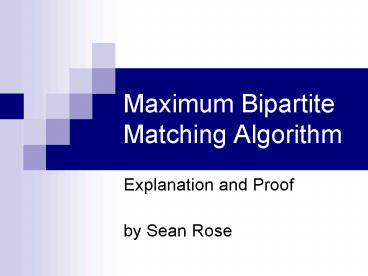Maximum Bipartite Matching Algorithm - PowerPoint PPT Presentation
1 / 15
Title:
Maximum Bipartite Matching Algorithm
Description:
Maximum Bipartite Matching Algorithm. Explanation and Proof. by Sean Rose ... Konig's Theorem: In a bipartite graph, a matching M is maximum, and a node cover ... – PowerPoint PPT presentation
Number of Views:442
Avg rating:3.0/5.0
Title: Maximum Bipartite Matching Algorithm
1
Maximum Bipartite Matching Algorithm
- Explanation and Proof
- by Sean Rose
2
Goals of Presentation
- Show that the algorithm performs as claimed
- At termination show
- C found by algorithm is a node cover
- M found by algorithm is a matching
- M C
- Discuss the complexity of the algorithm
3
Finding a Node Cover
X
Y
- A node cover C ? V is a set of vertices such that
every edge in G is incident with a node in C - Konigs Theorem In a bipartite graph, a matching
M is maximum, and a node cover C is minimum IFF
M C - If algorithm ends at step 1 then
- M X Y
- let C X
- then M C
- so C is a minimum node cover
C
M
4
Finding a Node Cover
G
X
Y
Td
a
a
f
f
b
b
c
g
g
d
d
h
Even Odd
e
i
M
5
Finding a Node Cover
X
Y
- Let P be the nodes not belonging to an
alternating tree - P c,e,h,i
- Note that half of the nodes in P belong to X and
the other half to Y - Let CP P ? X
- CP c,e
- Let No be all odd nodes
- No f,g
- Claim C CP ? No is a node cover
- C c,e,f,g
a
f
M
b
P
No
Ne
c
g
d
h
e
i
6
Finding a Node Cover
X
Y
- Assume C isnt a node cover
- then there exists an edge not incident with any
node in No or any node in Cp - 3 possibilities for e uv
- u?Ne, v?No
- u?P, v?No
- u?Ne, v?P
- such an edge cannot exist, so C is a node cover
a
f
M
P
No
b
e?
Ne
e?
c
g
e?
d
h
e
i
7
Prove M is a matching
- A matching is a set of edges without common
vertices - Initially
- M Ø, so M is trivially a matching
- At each augmentation step
- M M ? P, for an M-augmenting path P
- Recall the definition of an M-augmenting path
- a path joining two nodes u,v such that the edges
are alternatively in, and not in M, and neither
u, nor v are saturated by M
8
Prove M is a matching
G
Matching M
Matching M M ? P
M-augmenting path P
9
Prove M is a matching
- Assume M M ? P isnt a matching?
- There exists two edges in M that share a vertex
- 4 possibilities
- e1,e2 ? M
- e1,e2 ? P
- e1 ? M, e2 ? P
- e1 ? P, e2 ? M
- M M ? P never contains two such edges, thus M
is a matching
y
x
z
10
Prove M C
- Let U be nodes not saturated by M
- If U Ø then
- terminate at step 1
- M X Y V/2
- C X
- C X M
11
Prove M C
X
Y
- If U ? Ø then
- M 1/2 V\U
- Each alternating tree has
- one more even node than odd nodes
- one node in U (the root)
- Ne No U
- Three types of disjoint vertices
- V Ne ? No ? P
- V Ne No P
- V 2No P U
- V\U 2No P
- 1/2 V\U No 1/2 P
- Recall
- half of the nodes in P are in X
- CP P?X
- CP 1/2 P
- C No ? CP
- C No CP
- C No 1/2 P
a
f
U d
M
b
P
No
Ne
c
g
d
h
e
i
12
Algorithm Structure
- Step 0 Initialization
- Step 1 Termination Test
- Step 2 Beginning Forest Growth
- Step 3 Edge Selection
- Step 4 Growth
- Step 5 Augmentation
- Step 6 Termination
S0
S1
S2
S3
S5
S4
S6
13
Algorithm Complexity
14
Algorithm Complexity
- Total Complexity max1, n, n2,mn
O(mn) - Hopcroft-Karp algorithm has complexity O(mn1/2)
- Method based upon fast matrix multiplication has
complexity O(n2.376) - better in theory
- slower in practice
15
Questions
?































